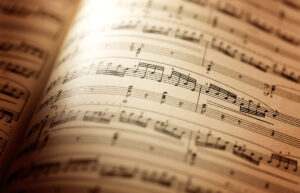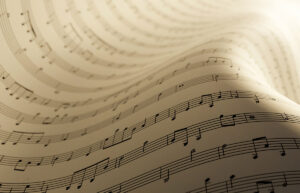What is Treble in Music? Meaning, Origin, Types & More

Welcome to the world of musical heights! Have you ever gazed at the shimmering sparkle atop a melody or pondered the celestial notes dancing above the rest? That’s the enchanting realm of treble. Embark on a sonic journey with me as we uncover the mysteries of treble—a musical domain where clarity, brightness, and the ethereal converge. Get ready to explore what is treble in music, understand its significance, grasp its influence on your favorite tunes, and witness how it molds the very essence of musical expression. Are you prepared to soar into the captivating realm of treble? Let’s dive in!
Welcome to TheDemoStop, now join the community!
Connect with artists, fans and producers around the world.
What is treble in music?
Treble denotes the higher range of musical tones, covering the elevated frequencies within the sound spectrum. In musical notation, it’s symbolized by notes placed higher on the staff. Instruments or voices that generate higher-pitched sounds, such as flutes, violins, female voices, or the higher-register sections of a piano, play a pivotal role in the treble range. Understanding what is treble in music extends beyond this; it is essential for infusing brightness, clarity, and definition into music, often bestowing melodies with their distinctive and vibrant characteristics. This stands in contrast to bass, which encompasses lower-pitched tones, collectively forming the complete tonal spectrum in music.
What is treble clef?
The treble clef, recognized as the “G clef” because of its stylized “G” shape, is a symbol in music notation signifying higher-pitched notes. This clef is commonly employed for instruments with elevated ranges, including the right-hand notes of the piano, violin, flute, and higher-pitched vocals.
Origin of treble in music
After understanding what is treble in music, it’s important to understand its origin. The term “treble” has its roots in medieval music, particularly within polyphony—a style featuring multiple independent melodic lines performed simultaneously. In this musical context, composers organized different vocal parts: the lowest voice was the “tenor,” the middle voice was the “altus,” and the highest voice was known as the “triplum” in Latin, representing the third voice. As language evolved, “triplum” transformed into “treble.”
Over time, the term expanded beyond its initial meaning of a specific vocal part, encompassing a higher range of musical notes and frequencies. It was associated with the brighter, clearer sounds in the upper registers of various instruments and voices. This linguistic evolution led “treble” to symbolize the higher-pitched elements in music, distinct from the lower-pitched bass tones. In contemporary times, it plays a crucial role in musical compositions, contributing clarity, definition, and a vibrant quality to melodies and harmonies across a diverse range of musical genres and styles.
Why is treble important in music?
Treble holds significance in music primarily because it carries the melody, the central and most recognizable aspect of many compositions. Its higher frequency range gives clarity to the main musical line, making it easily distinguishable from other elements. This clarity allows listeners to follow and connect with the tune more effectively. Understanding what is treble in music lets you have clarity of tonal balance. Alongside bass frequencies, treble completes the spectrum of tones, ensuring a well-rounded and harmonious sound. This balance is essential for a piece of music to feel complete and sonically satisfying.
Types of treble in music
Lower treble (4.000 Hz-6.000 Hz)
Within the realm of music and considering what is treble in music, the lower treble segment occupies a position just above the midrange frequencies, infusing the sound with a sense of warmth and depth. This segment includes the higher notes of instruments found in the midrange, such as certain parts of guitars or specific sections of the piano. Moreover, in vocals, it can extend to cover the higher registers of tenor voices.
The lower treble range enhances tonal complexity by adding richness to the overall composition, seamlessly blending with midrange frequencies without overshadowing them. Acting as a foundational layer within the treble spectrum, it provides a balanced yet sonically engaging experience.
Mid-treble (6.000 Hz-10.000 Hz)
Nestled in the center of the treble spectrum, the mid-treble range encapsulates the brighter and more pronounced elements of higher registers. These frequencies play a crucial role in enhancing the clarity, definition, and articulation of the melody.
Serving as the bearer of the most discernible parts of the musical line, the mid-treble range injects compositions with brilliance and sparkle. Its significance lies in shaping the overall brightness and excitement of a musical piece, ensuring that the melody stands out clearly and resonates amidst other musical elements.
Upper-treble (10.000 Hz- 20.000 Hz)
At the extreme high-frequency end of the treble spectrum lies the upper treble range, housing the most ethereal and airy components of music. This domain includes overtone, harmonics, and the highest notes produced by instruments like piccolos, electronic synthesizers, or the upper registers of certain female vocal ranges.
The upper treble introduces an additional layer of brightness and a feeling of expansiveness to compositions. Its contribution results in an intricate and detailed texture, providing a heightened sense of complexity and depth within musical arrangements. This range plays a crucial role in infusing a sense of lightness and delicacy, often enhancing the overall emotional impact of the music.
Treble in different music genres
Treble in rock music
In rock music, the treble range plays a crucial role, especially with guitars—a fundamental instrument in the genre—often taking center stage in the treble spectrum. The sharp, bright tones produced by electric guitars, slicing through the mix, are predominantly found in the mid-treble to upper-treble ranges. This brightness and clarity are key contributors to the energetic and aggressive sound signature characteristic of rock music. Furthermore, rock drumming tends to accentuate cymbals and high hats, residing predominantly in the treble frequencies. This emphasis adds rhythmic accents and propels the momentum of the music.
Treble in jazz music
In the realm of jazz music, the utilization of what is treble in music becomes a nuanced art. Instruments such as saxophones, trumpets, and hi-hats play pivotal roles within the treble spectrum. The expressive nature of saxophones and trumpets heavily relies on their adeptness at hitting mid to upper-treble notes, enabling intricate improvisations and melodic embellishments.
In jazz drumming, hi-hats introduce rhythmic complexity and subtlety within the treble range. The treble elements in jazz contribute to the genre’s improvisational nature and its ability to create richly textured, dynamic musical experiences.
Welcome to TheDemoStop, now join the community!
Connect with artists, fans and producers around the world.
Treble in pop music
Pop music frequently highlights a distinct and memorable melody, with the treble range serving a crucial role in achieving this effect. Vocal lines, particularly in higher registers, are the core of many pop melodies. Furthermore, instruments like synthesizers, known for producing bright and shimmering sounds prevalent in pop music, operate within the treble range. These synthesizers contribute hooks and catchy motifs that complement the vocal melodies.
The treble’s clarity and brightness are essential elements in crafting an uplifting and danceable atmosphere, instantly making pop music appealing and memorable.
Treble in classical music
In classical music, various instruments across different sections of an orchestra or ensemble utilize the treble range. String instruments such as violins and flutes frequently lead the melody, performing in the treble register to infuse classical compositions with brightness, clarity, and expressive qualities. Additionally, the intricate harmonies played by higher-register instruments like piccolos or oboes are crucial in creating delicate and detailed textures within classical music. These elements convey emotion, intricacy, and the sheer beauty of melodic lines, contributing to the genre’s rich tapestry of sound. Exploring what is treble in music unveils its significant role in shaping the nuanced and emotive aspects of classical compositions.
Instruments that produce treble sounds
Flute
The flute, categorized as a woodwind instrument, excels in delivering bright and clear tones, showcasing a perfect embodiment of what is treble in music. Its slender design and nuanced fingering, which governs a range of pitches, allow the flute’s sound to resonate seamlessly in the mid to upper treble frequencies. This unique capability opens up a wide array of expressive and melodic possibilities, emphasizing the instrument’s significance in the treble realm of musical composition.
Violin
The violin, a staple in orchestras and various music genres, produces clear and vibrant treble notes. Its four strings, when bowed or plucked, resonate in the higher frequency spectrum, contributing to the characteristic rich, bright, and soaring melodies associated with the instrument.
Trumpet
As a brass instrument, the trumpet generates piercing and bright treble sounds. Its design and mouthpiece allow players to produce high-pitched notes in the treble range with power and clarity. The trumpet’s ability to project in the upper frequencies makes it a crucial instrument in many musical genres, from classical to jazz and beyond.
Saxophones
Saxophones, available in various sizes and pitches, produce treble notes with a unique blend of warmth and brightness. These woodwind instruments operate across the mid to upper treble range, making them versatile for melodies, solos, and harmonies in jazz, classical, and popular music genres.
Mandolin
The mandolin, a stringed instrument from the lute family, produces bright and resonant treble notes. Its pairs of strings, usually tuned in unison or octaves, create shimmering tones in the treble spectrum. The mandolin’s plucked strings emit a characteristic sound that complements various music styles, contributing melodic richness in the higher frequencies.
Bagpipe
Bagpipes, with their unique read-based design, produce treble sounds that resonate across higher frequencies. The drone and chanter together create a mix of higher-pitched tones, with the chanter specifically contributing to the treble range. This distinct sound adds color and depth to traditional folk music.
Clarinet
The clarinet, a versatile woodwind instrument, produces clear and expressive treble notes. Its range spans across the mid to upper treble frequencies, allowing for melodic richness and tonal variation. The clarinet’s cylindrical shape and reed mouthpiece create its characteristic bright and resonant tones.
Guitar
Guitars, particularly acoustic and electric guitars, produce treble notes among their various tonal ranges. The higher strings of the guitar, when plucked or strummed, generate bright and clear tones in the treble spectrum. These treble notes often contribute to melodies, harmonies, and intricate fingerpicking patterns in a wide array of music genres.
How does treble affect sound quality?
Bass
Treble significantly affects the overall sound quality by complementing the bass frequencies. The interplay between treble and bass is crucial for achieving balanced audio output. Treble adds clarity and definition to the higher frequencies, preventing the sound from becoming overly heavy or muffled, thereby maintaining a well-rounded and clear sound. Properly managed treble ensures the bass doesn’t overpower the entire audio spectrum, creating a balanced and enjoyable listening experience across various music genres and audio formats.
Midrange
Treble also impacts the quality of the midrange frequencies. While the midrange carries much of the music’s body and detail, the addition of appropriate treble enhances its clarity and articulation. Well-handled treble prevents the midrange from sounding muddy or dull by adding sparkle and definition to instruments and vocals within this range. This collaboration between treble and midrange contributes to the overall richness and presence of the sound.
Imaging
Treble plays a vital role in sound imaging, defining the spatial characteristics and depth perception within the audio. By accurately reproducing high-frequency sounds, treble contributes to the spatial cues that allow listeners to perceive the placement and distance of various instruments or voices within the soundstage.
Well-defined treble allows for precise localization of instruments or sound elements, creating a clearer and more immersive listening experience. In audio systems capable of accurately reproducing treble, the imaging becomes more detailed and realistic, enhancing the overall sense of depth and realism in the sound.
Welcome to TheDemoStop, now join the community!
Connect with artists, fans and producers around the world.
Conclusion
What is treble in music?
Treble in music refers to the higher range of audible frequencies, contributing clarity, brightness, and definition to musical tones. It encompasses the higher-pitched notes, adding richness to melodies and complementing the lower-pitched bass frequencies for a balanced sound.
Origin of treble in music
The term “treble” in music originated from the Latin word “triplum,” signifying the highest part in medieval polyphony. Over time, it evolved to denote the higher range of musical tones and became associated with brightness, clarity, and the upper frequencies in music.
Why is treble important in music?
Treble is important in music as it provides clarity, brightness, and definition to melodies, balances the overall tonal spectrum, adds emotional depth, and enables artistic expression within a composition.
Types of treble in music
- Lower treble (4.000 Hz-6.000 Hz)
- Mid-treble (6.000 Hz- 10.000 Hz)
- Upper treble (10.000 hz- 20.000 Hz)
Treble in different music genres
- Treble in rock music
- Treble in jazz music
- Treble in pop music
- Treble in classical music
Instruments that produce treble sounds
- Flute
- Violin
- Trumpet
- Saxophones
- Mandolin
- Bagpipe
- Clarinet
- Guitar
How does treble affect sound quality?
- Bass
- Midrange
- Imaging
FAQs
What is treble in music?
Treble in music encompasses a higher range of audible frequencies, including higher-pitched notes and instruments, contributing brightness and clarity to musical tones. This quality allows it to stand out distinctly within the overall audio spectrum.
What is the origin of treble in music?
Originating from the Latin word “triplum” in medieval polyphony, treble evolved over time to symbolize the higher range of musical tones, emphasizing characteristics such as brightness and clarity.
Why is treble in music important?
Treble is crucial for providing clarity, brightness, and definition in melodies, playing a significant role in contributing to the emotional depth and artistic expression within musical compositions. Its importance lies in creating a nuanced and vibrant sonic experience.
What is treble clef?
The treble clef, also known as the “G clef,” is a symbolic representation of higher-pitched music notes. Its shape resembles a stylized letter “G.” This visual cue is a fundamental guide for musicians reading sheet music.
What are the different types of treble?
The audio spectrum encompasses lower treble (4.000 Hz- 6.000 Hz), mid treble (6.000 Hz- 10.000 Hz), and upper treble (10.000 Hz- 20.000 Hz), each contributing unique characteristics to the overall sound profile.
What are the advantages of high treble in equalization?
High treble in equalization brings several advantages, enhancing audio with clarity, brightness, detail, and presence, thereby contributing to an overall improvement in articulation and definition within the higher frequency range. This deliberate adjustment allows for a more refined and nuanced auditory experience.
What happens if the treble is too high?
Excessive treble in music can lead to issues such as harshness, ear fatigue, and an unbalanced sound, with an undue emphasis on high frequencies that may affect the overall listening experience.
What is treble vs bass vs mid?
In the audio spectrum, treble represents higher frequencies, bass signifies lower frequencies, and mid corresponds to middle frequencies, collectively shaping the tonal balance and character of the sound.
How does treble affect sound quality?
Treble influences sound quality by providing clarity, defining melodies, and contributing to the overall balance and brightness within audio, playing a crucial role in shaping the listening experience. This impact extends beyond technical aspects, significantly influencing our emotional connection to the music.































































